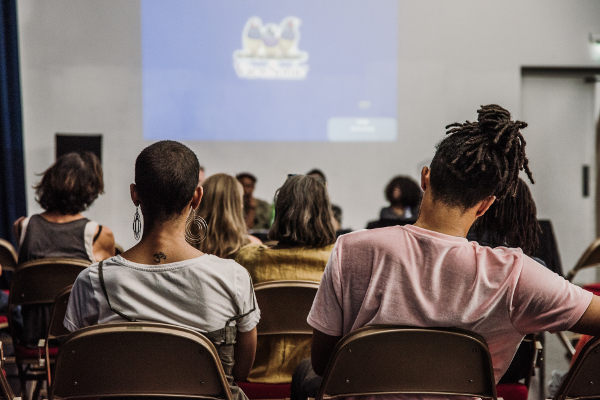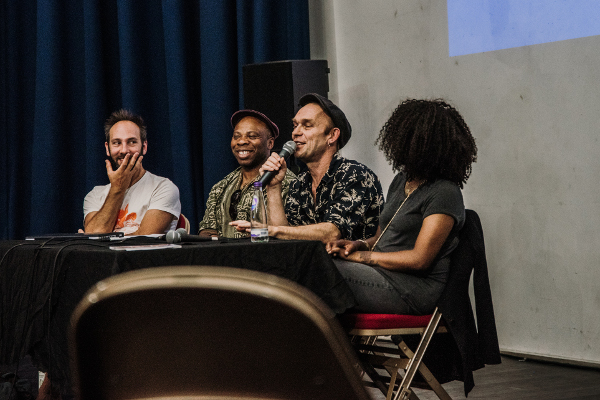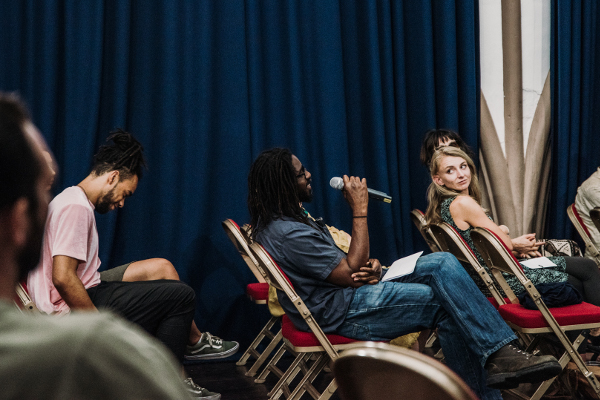Gentrification or redevelopment?

Fyfe Hall filled up for the penultimate talk in the series @Khali Ackford
There was a lot of excitement within the team about this event as we knew the panel members would be really interesting and bring good insight to Bristol’s current art scene. There was a last minute change so Daniel Balla from Coexist joined us in place of Greg Bond who was unable to attend. Michele Curtis and Doug Francis joined us as planned, and our own Dr Edson Burton chaired the evening.
Coexist’s Daniel started by explaining their approach to serving the community. He spoke about the way that cultural ecology is not fixed, it is constantly recreated. A central concern of gentrification has and always will be the displacement of people from the community that used to occupy that space, physically or spiritually, in society. Some art installations at Hamilton House have expressed this by communicating the unpredictable nature of the facade and behind by having volunteers speak about their lives behind a screen for attendees to listen to. He mentioned that national newspapers such as The Guardian site Stokes Croft as the epitome of gentrification, so Coexist have a big responsibility to critique their own actions and what other organisations do to serve their community.
"Should we be calling this gentrification at all or rather redevelopment? What defines gentrification could simply be the monetisation of the social world."
One of the main subjects of conversation throughout the evening was the need to conform with capitalist needs while making art, in order to succeed. These organisations have rent to pay and therefore have had to learn how to generate capital through a variety of means. In the case of Coexist, they have hosted activist groups such as the Bristol Drugs Project as well as commercial income from artist studios, dance studios, and desk space. The model has to be reactive to the community, for example after engaging with the community to see where the need was, they set up a Somali kitchen.

On the panel from left to right, Coexit's Daniel Balla, Trinity'sDr Edson Burton, ASLS's Doug Francis and visual artist Michele Curtis @Khali Ackford
There were also questions raised about the use of language- should we be calling this gentrification at all or rather redevelopment? What defines gentrification could simply be the monetisation of the social world. In terms of where Coexist sits- the future is uncertain. The organisation always assumed it would be able to buy the building when the time was right, however this year their landlords have quadrupled the rent, throwing all future plans into the air. This has motivated the team to think about Coexist’s future. They critiqued the system and they now want to make a network between arts organisations so that they can support and stand up for one another like a union.
Michele Curtis’s career in visual art began in 2015 in St Paul’s with a mural and walking tour project. She wanted to communicate the local history visually by painting large murals, and proposed this idea to somebody, who strongly advised to act immediately. Michele described how at the time she did not consider why, but that with hindsight she believes he gave this advice because he could see the area was changing and in the near future, people living there would not want massive murals of black people’s portraits. She projected to the audience a feeling of motivation, encouraging artists to act on their ideas and make art happen.
"...the power lies with artists, therefore we must continue to make art, and fight for arts organisations."
Doug Francis comes from a long art background, originally doing events in the Portobello Road area of London before moving to Bristol where there was still opportunity. In this instance, Doug talks about opportunity in terms of buildings that can still be used to hold raves, parties and art events cheaply or for free. He said that he did not look forward to anticipate what would be happening now. With friends, he occupied garages up Cheltenham Road, and what they did differently from other groups of artists was they opened up their squat to invite the local community in. Doug is also the ringmaster of The Invisible Circus, with outrageous costumes, props and staging. When Artspace Lifespace took The Island over from Urban Splash, with enormous pride he described it as the clowns taking over the police station, the lunatics taking over the asylum. Other venues they have around Bristol include the Loco Club under Temple Meads, the Vestibules at the Council House on College Green, and most recently acquired, Ashton Court.
He has made art in many ways and in lots of different places and media. Recently he even had a job in the Somerset council, trying to re-purpose the Tropicana Centre after Banksy’s Dismaland residency. The feeling we were left with was that the power lies with artists, therefore we must continue to make art, and fight for arts organisations.

Questions from the floor created lively debate about gentrification in Bristol. Photo @Khali Ackford
After each panellist had spoken about their work individually, the floor was open to questions. There was a good mixture of debate, and a sense that the audience was in it together, fighting for the same side. The amount of knowledge sharing was inspiring, for example an audience member made us all aware about the Living in Vehicles consultation which is happening at Bristol City Council.
The panel made it a richly interesting, energetic evening of discussion, for which we thank them. Catch the last talk in our series on the 31st July at 7pm, ‘Reconstructing Trinity: From Disrepair to Glory’. It will be another panel discussion featuring Trinity members past and present, don’t miss out.
These notes are written by Tess Sieling, who is the project intern on the Heart & Soul heritage project. Read more of her notes on our Tuesday talk series - Father Paul, Fidel Meraz, A Million Bricks of Love, and Same Building, Different Meaning. Our talk series explores the challenges and achievements of transforming and preserving historic buildings and is programmed in collaboration with Bristol's Architecture Centre and the University of West England (UWE).




